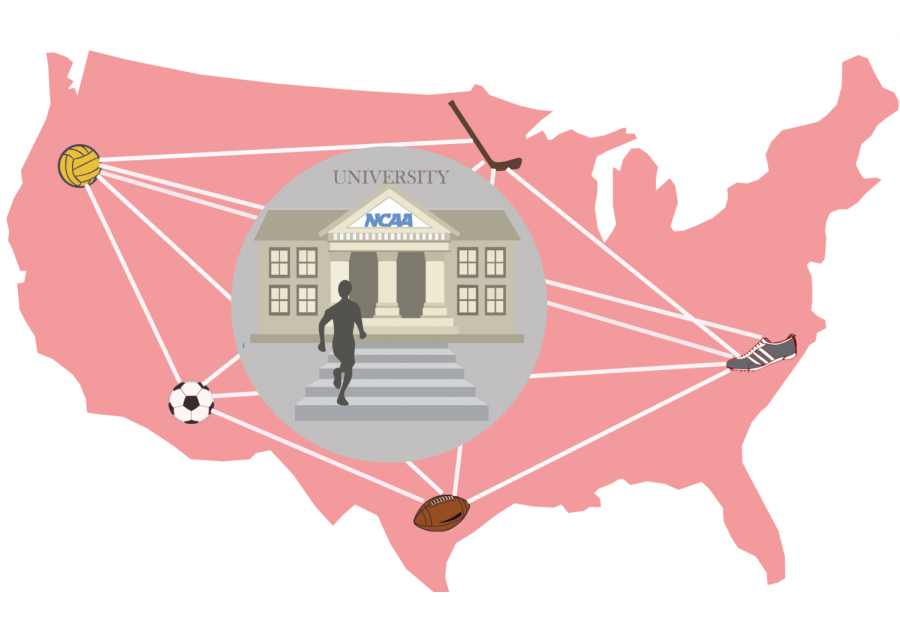The ins and outs of college athletic recruitment
May 3, 2019
The watchful eyes of college coaches follow a player on the court amid the cheers of parents and teammates. The repeated squeaks of sneakers and smacks from the contact of palm against ball reverberate across the court, echoing the erratic thumping of the nervous player’s heartbeat. For high school athletes aspiring to play their sport in college, every game counts toward their goal. Through years of hard work and discipline, they strive to get their achievements noticed by college recruiters.
A recent college admissions scandal that was revealed in March, however, has caused many to reexamine what it means to get into college through athletics. For instance, a parent bribed college officials to designate their daughter as a water polo recruit with a fake athletic profile, prompting outrage about the unethical use of privilege. That being said, the college recruitment process remains a regulated and streamlined process for the majority of prospective college athletes.
More than 1,100 colleges and universities are members of the National Collegiate Athletic Association (NCAA), an organization dedicated to providing opportunities for college athletes. Because of the NCAA’s diverse members that include schools ranging in size from those with hundreds of students to those with tens of thousands, the NCAA’s current three-division structure creates a level playing field.
Division I schools generally have the largest student bodies, manage the biggest athletics budgets and offer the highest number of athletics scholarships. Ivy League institutions, however, are an exception: although they are Division I schools, they do not offer athletic scholarships. Full athletic scholarships are more commonly awarded to Division I athletes than to Division II athletes, who typically receive partial scholarships as Division II schools are smaller in population and athletic department budget size. The Division III experience has less of a focus on competitive athletics, and while Division III athletes are not awarded athletic scholarships, a majority of such athletes are provided some form of merit or need-based financial aid.
According to the suggested high school timeline provided by the NCAA, students who look to play sports in college should register for a profile page with the NCAA Eligibility Center during their sophomore year of high school. To play sports at a Division I or II school, students must graduate from high school, complete 16 NCAA-approved core courses, earn a minimum GPA of 2.3 for Division I and 2.2 for Division II and meet certain ACT or SAT score requirements. When students register for eligibility, the NCAA also asks for details regarding the student’s sports participation history for awards they have received, any teams they have played with or certain events in which they participated outside of the traditional high school season.
The National Association of Intercollegiate Athletics (NAIA) is another college athletics association for small colleges and universities in North America. It has 251 member institutions, two of which are in British Columbia, one in the U.S. Virgin Islands and the rest in the contiguous U.S. Generally, colleges participating in NAIA are smaller than NCAA colleges, and the NAIA recruiting process for both freshmen and transfers has fewer restrictions on the communication between a prospective student-athlete and a coach. Other college sports associations include the National Junior College Athletic Association for community college, state college and junior college athletics. Each association has specific requirements for eligibility, and schools participate in different associations depending on size and other criteria.
“When I emailed the college coach before visiting the campus, the coach agreed to show me the facilities and conduct an interview,” said senior Grace Tian, who has committed to fence at Duke University. “There, I responded to questions and gave them my academic stats and fencing results. In August of my senior year, the coach let me know that they wanted to recruit me and that I should apply early decision. In my application, I still had to write essays and have letters of recommendation, but I got my acceptance email early, around November.”
In terms of the methods coaches use to communicate with prospective recruits, the NCAA’s rules have evolved to reflect the younger generation’s preferences.
“Every coach kind of has his or her own style, but the NCAA rules have changed over the years,” said David Rasmussen, senior associate athletics director at San Jose State University. “When I first started, coaches couldn’t text any recruits at any time. Then, a couple years back, the Coaching Associations decided that high school students don’t like to communicate by phone anymore. So, then, they opened up texting and social media. You can friend or follow someone, or recruit on social media, but you can’t comment on [a student’s] public profile.”
However, with expectations to maintain both academic and athletic performance, student-athletes can often feel under pressure. Student life can be stressful enough, but according to a 2005 study by online journal Athletic Insight, student athletes reported higher than usual stress in several variables than general students, including: having many responsibilities, not getting enough time for sleep and having demanding extracurricular activities.
“Every single tournament I went to, there were always at least 20 college coaches watching,” said Amy Steinmetz, former Division I athlete, Lynbrook Class of 2018 alumnus and current freshman at the University of California, Irvine (UCI). “So, there’s the pressure that you always have to be on your A-game, because you don’t know who’s going to be watching. Everybody has pressure to do well, but sometimes, when you feel pressured, you tend to do worse. So, you have to have a good mindset.”
To commit to a school, students can sign a National Letter of Intent (NLI) to agree to attend a Division I or II college for one academic year. NLI member institutions agree to provide athletics financial aid for a minimum of one academic year as long as a student is admitted to the school and is eligible for financial aid under NCAA rules. The NLI is voluntary and not required for students to receive financial aid or participate in sports, but signing a NLI ends the recruiting process for an athlete because coaches are prohibited from recruiting student-athletes who have signed NLIs with other NLI member institutions. The NAIA does not have a letter of intent program in which students sign a binding agreement to participate in athletics at a particular institution. Student-athletes may sign letters of intent with an individual NAIA school, however, they aren’t obligated to attend that institution.
“UCI gave me the best scholarship, but I also went for an unofficial visit where I met the team and the coach,” said senior Megan Yang, who has committed to playing golf at UCI. “I’m excited to play a sport where the school accommodates you, because from what I’ve heard from the coach so far, I will be able to pick my classes first to work around the golf schedule. The teachers will set up special testing times, and they’ll give you extra tutors if you need it.”
Of the student-athletes participating in sports with professional leagues, very few become professional athletes — there are more than 480,000 NCAA student-athletes, and fewer than 2 percent will become professionals in their sports. For the rest, the experiences and life lessons that come with college athletics help them pursue careers in other fields. Through participation in college sports, student-athletes find opportunities to learn and compete while receiving academic support, medical care and access to coaching, facilities and equipment, allowing students to grow athletically, academically and as people.


































































